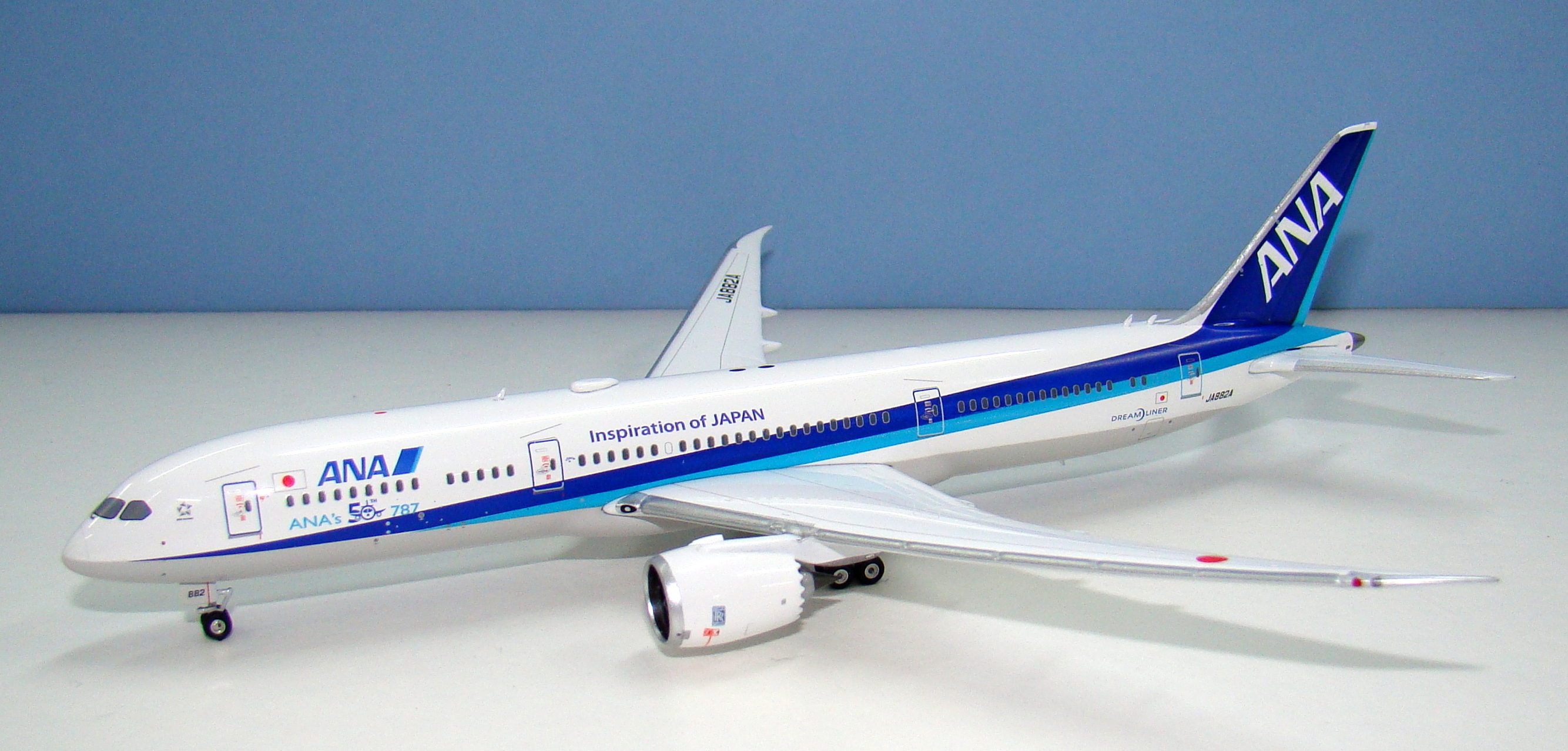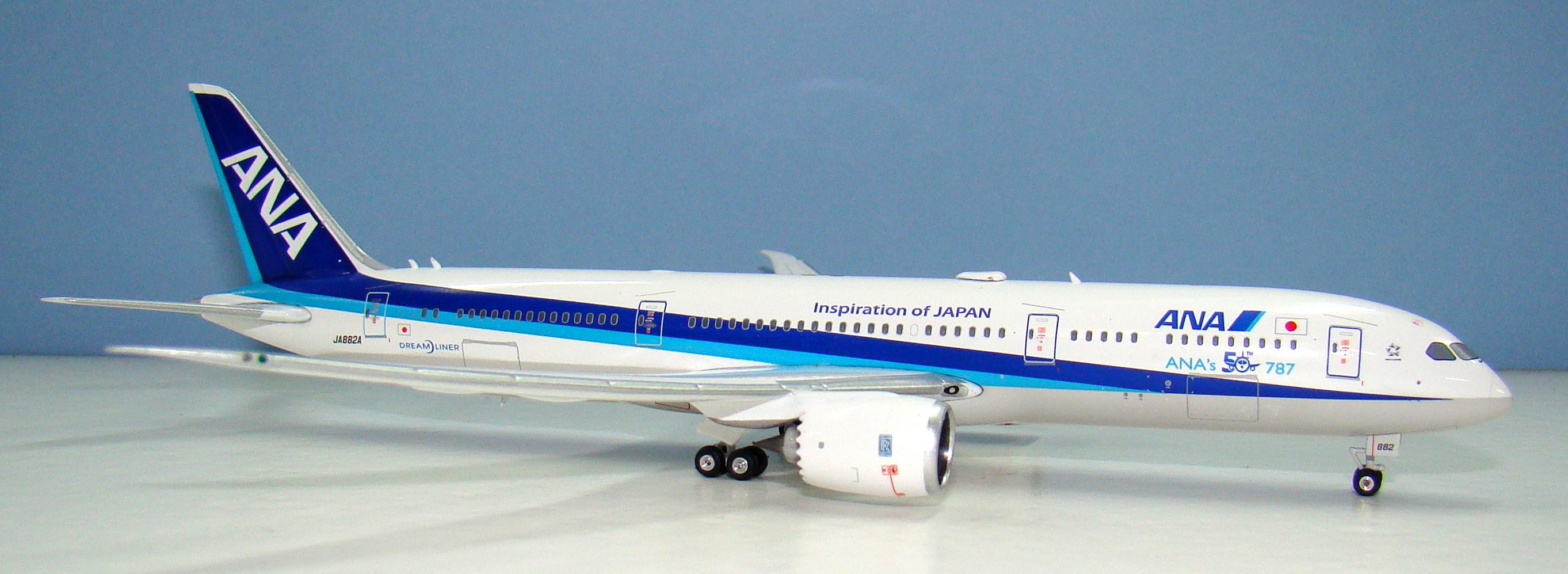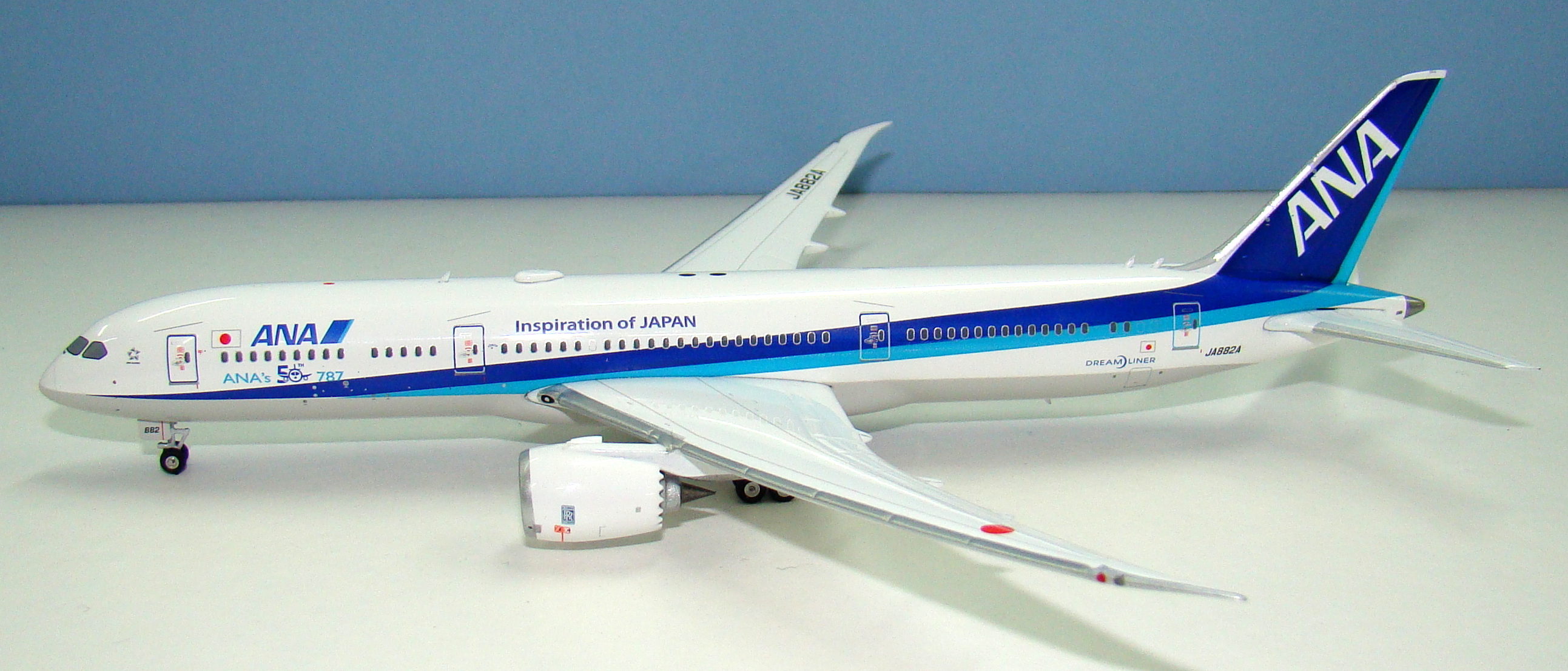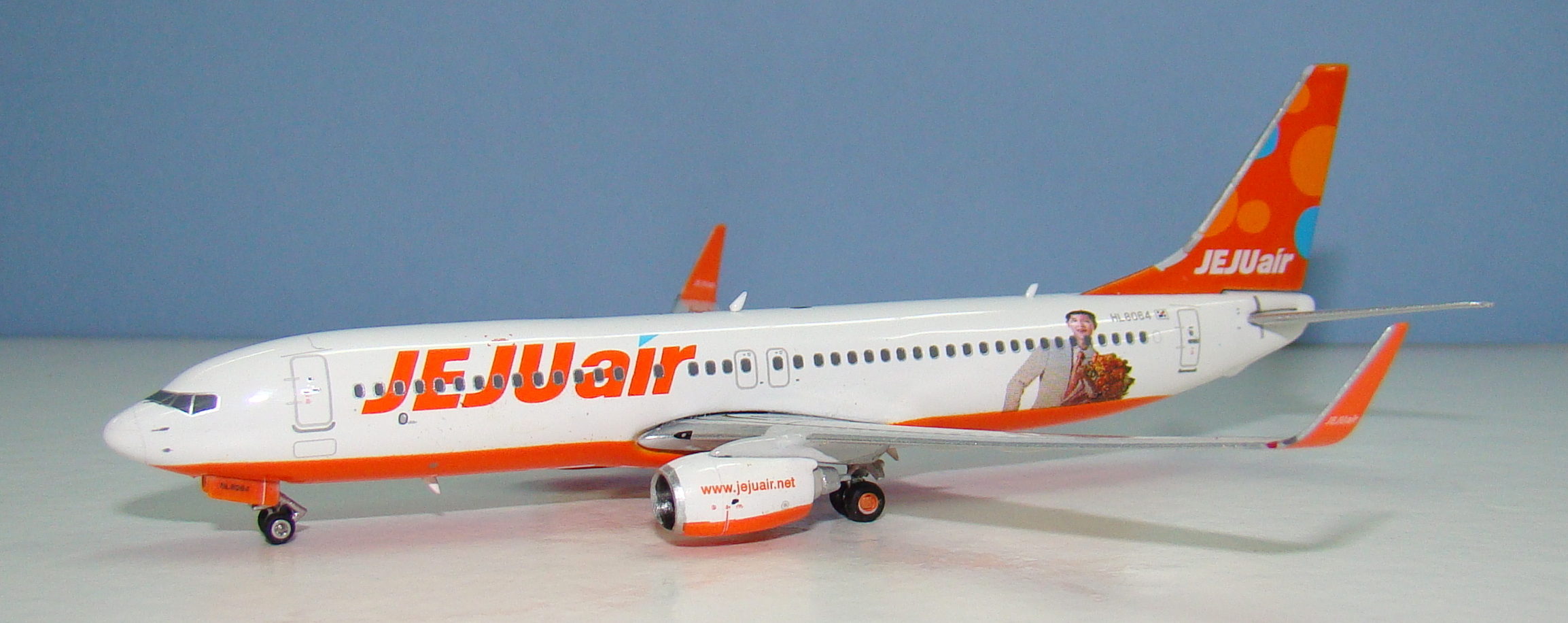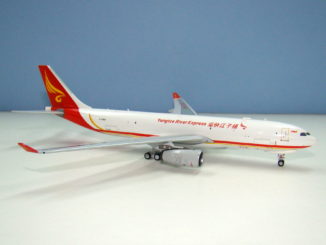
Phoenix has been at the forefront of 1/400 scale modern widebody airliners (ignoring their awful 747-400) for several years and its A330s, A380, B747-8, B777s and B787s have a deservedly high reputation when it comes to the moulds. Recently JC Wings has been providing a real challenge to Phoenix in this area so does the Phoenix 787-9 hold up to the challenge?
THE REAL THING
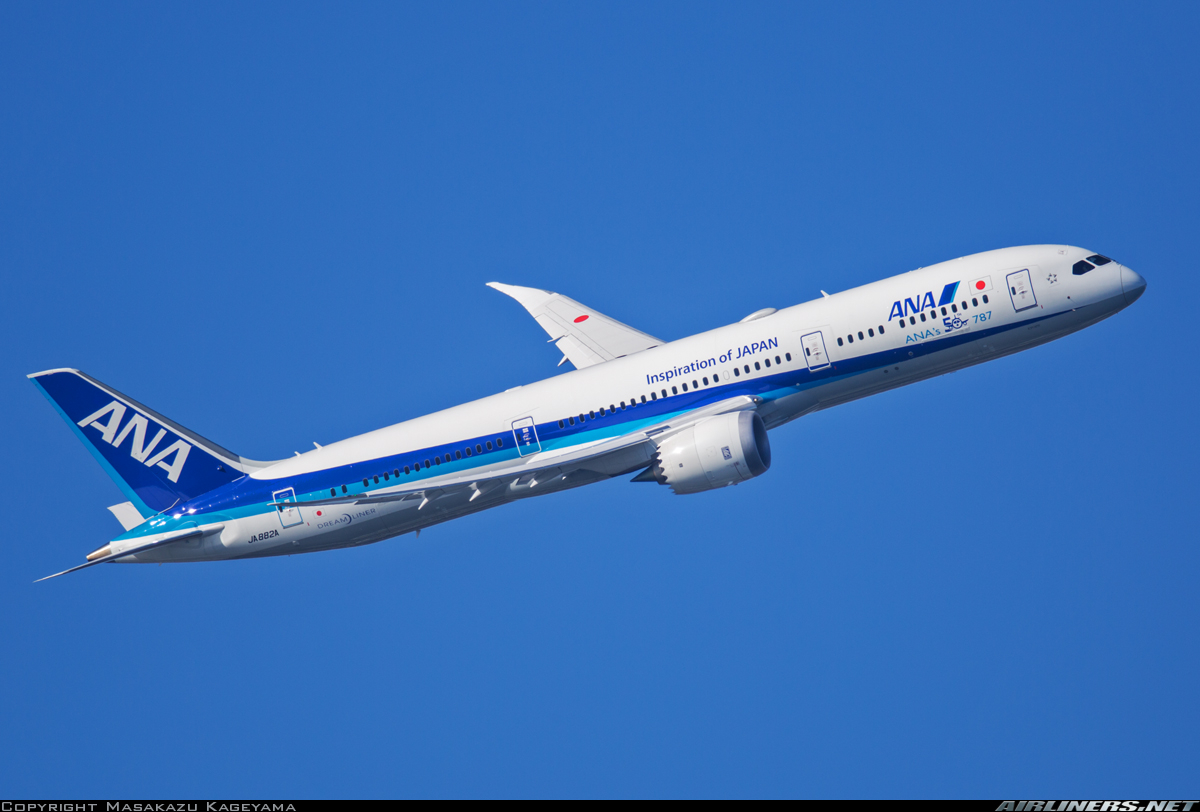
All Nippon signed on as launch customer for the Boeing 787 Dreamliner way back in 2004 but was made to wait until September 2011, over four years later than scheduled, before it took its first 787-8. They have stood by the Boeing product despite subsequent battery related issues and August 18th saw ANA take its 50th 787 from the Everett Delivery Centre. This aircraft, JA822A, has been decorated with special markings below the ANA titles to mark it out as the 50th aircraft. By May 2017 the fleet has been further swelled and now 58 examples (36 787-8s and 22 787-9s) are in service. This makes ANA easily the 787’s largest customer to date.
By the time that ANA accepted JA822A it was using the type on 40% of its international network. ANA has used the 787 for the role it was originally built for – to open up a range of long slim routes that were previously uneconomic. These include services from Tokyo to destinations like Phnom Penh, Mexico City, Dusseldorf, Brussels, Seattle and San Jose. All Nippon reports that the 787s are saving it about $98 million a year in fuel costs due to its 20% better economy than the 767 fleet. It’s no wonder that Osamu Shinobe, president and CEO of ANA, said:
“The 787 Dreamliner has played a significant role in opening up new routes into new markets, while also forming the backbone of our long-haul fleet,”
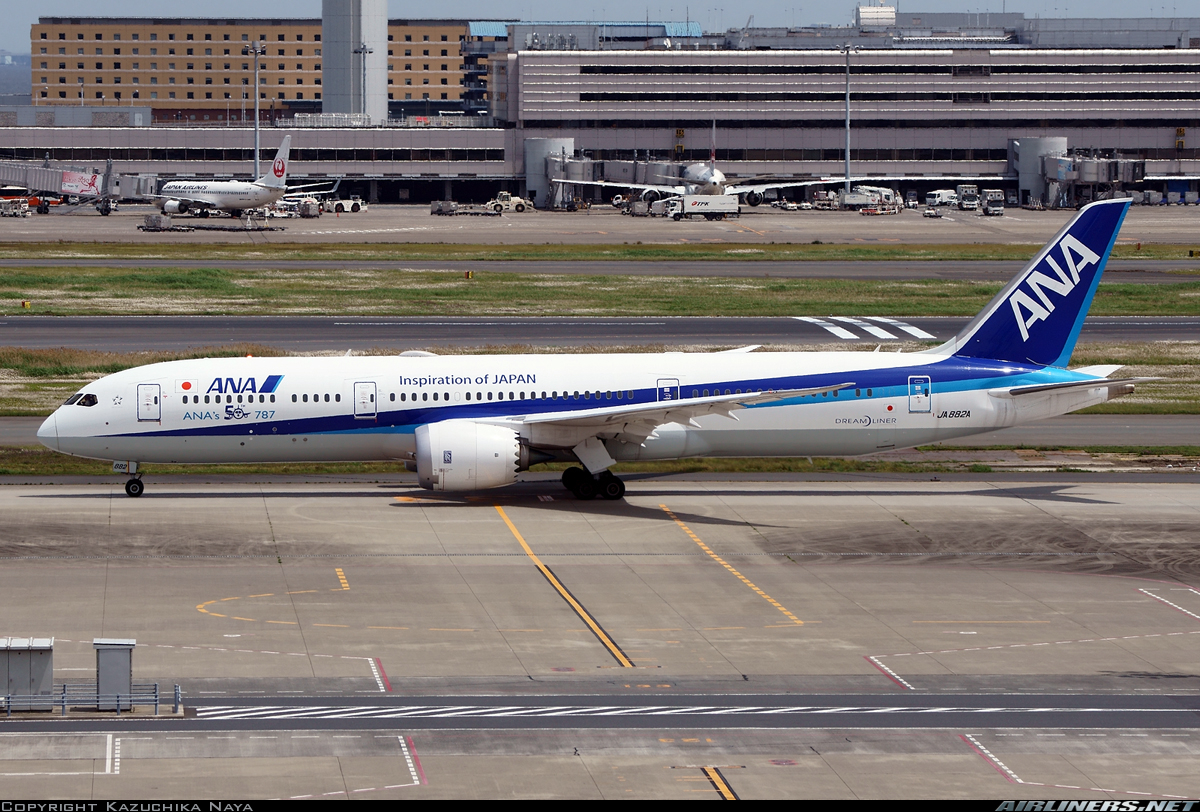
All Nippon still has a further 25 787s on order including the newest and largest variant – the 787-10. When these are in service it will be only one of three airlines (the others are BA and United) to operate all three versions. Just prior to its service entry the 50th airframe was used to undertake display flights at the 2016 Farnborough Airshow, however these were eclipsed by a video Boeing released of the same aircraft undertaking maneuvers, banned at airshows, over Moses Lake in preparation for the event. Not only is the 787 an incredibly efficient plane but without the added weight of passengers and cargo it is also a sprightly mover.
THE MODEL
The format for my reviews is to split them into three key areas:
- The mould of the aircraft
- The paint and livery
- Printing and quality control
Each can get a maximum score of 10 for a section giving a maximum combined total score of 30.
THE MOULD
The shape of the fuselage is good but not perfect. The shape of the rear fuselage and stabilizers are excellent but the tail cone is too pointed. Also the horizontal stabilizers sit too level. On the JC Wings mould they more correctly point a little upwards.
The the wing fuselage join and under fuselage middle are where the mould is weakest. The rear wing join is flush and not accurate as it lacks the fuselage strake. On the underside the mould is painfully vanilla. There is literally no detail in the mould at all here (and no printing either) – it’s as if Phoenix don’t expect you to ever look at the underside so haven’t bothered. The JC Wings mould shows the variety of inlet scoops perfectly. The wings themselves also have an unnatural curvature towards the tip, which is too strong for an on the ground look.
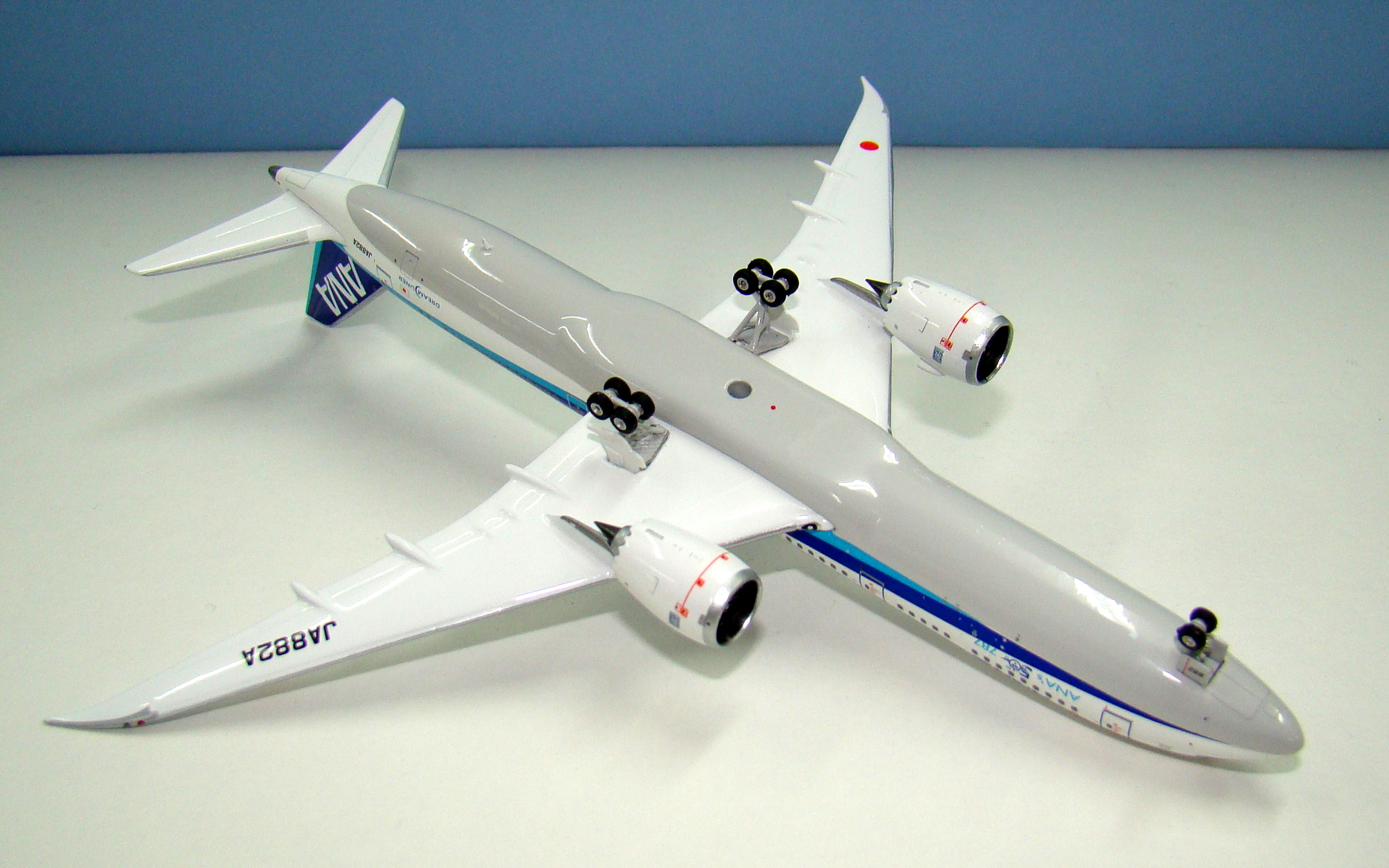
The area above the wing on the Phoenix mould is slab sided and does not show the curvature present on the real thing and is therefore again incorrect. On the plus side the front fuselage, nose, satnav dome and antennae are all well done. The forward roof antenna is smaller than on the JC Wings mould and the better for it.
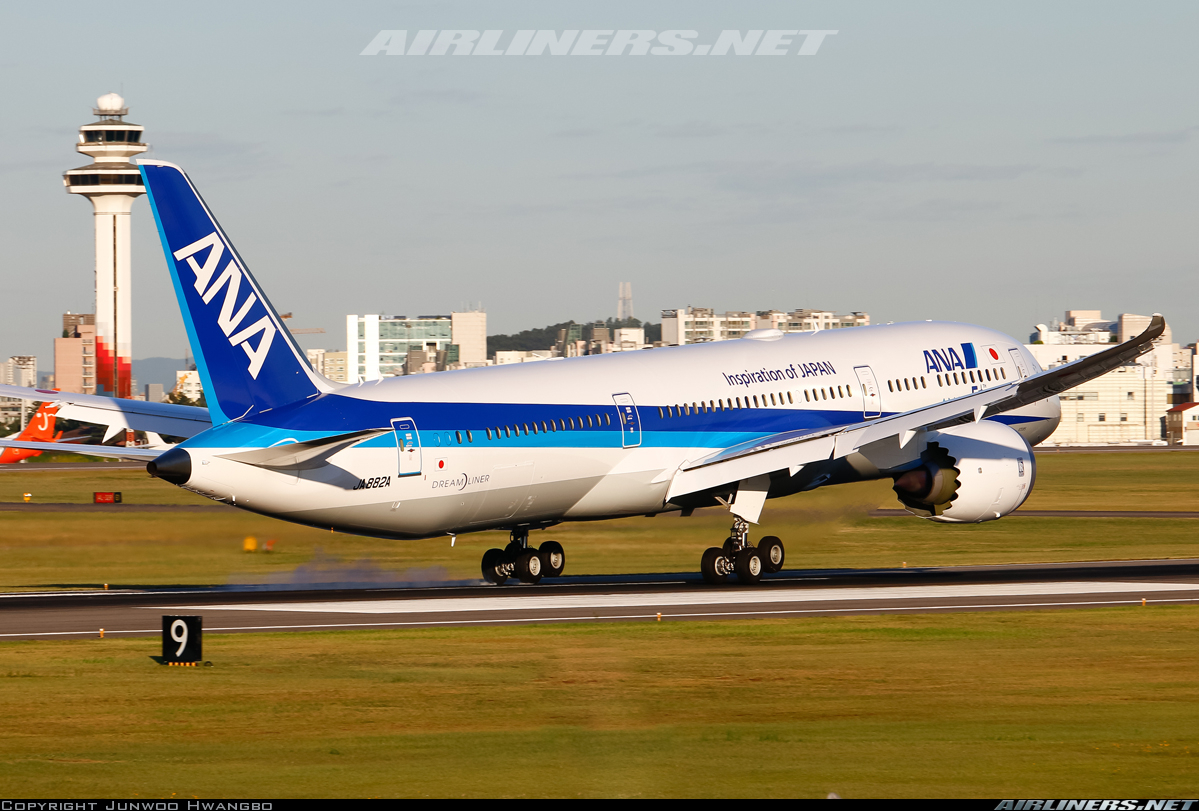
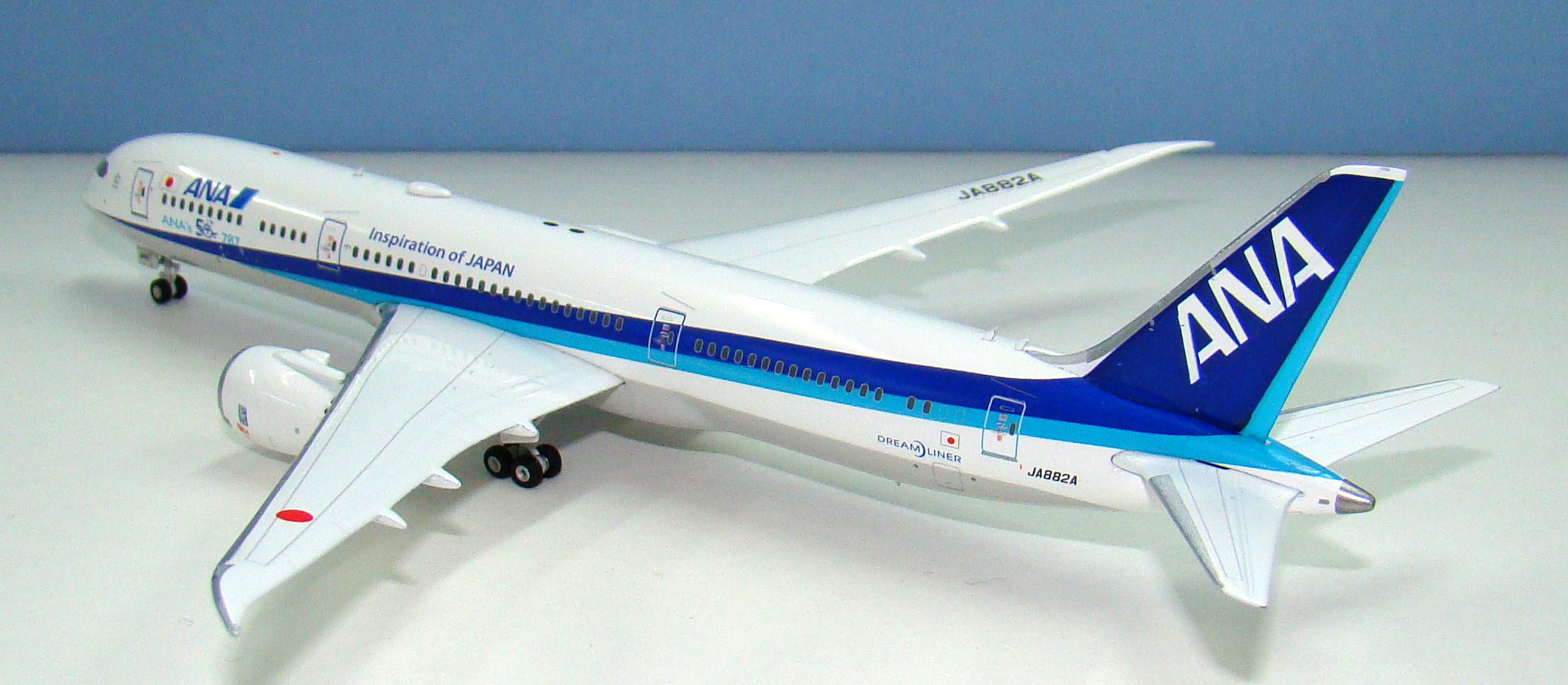
Looking at the engines and they are a good shape but are old style solid fans, not hollow see through engine fans as on the JC Wings model. They are also shorter than the JC Wings engines by a millimeter or so, which may account for why the rims at the front are too thin (see printing section).

The nosegear offers further comparison with the JC Wings model. The rear process on the leg is slightly too high but Phoenix have much superior metal coloured and better detailed wheelhubs than JC Wings do. The Phoenix landing gear is taller by about a millimeter giving the engines better ground clearance than the JC Wings model, however side by side I actually think the shorter JC gear is more accurate.
Comparing the latest Phoenix and JC Wings 787s shows the Phoenix mould to be substantially inferior. The Phoenix mould is still ok but it is weaker around the fuselage / wing area, tail cone / wing angle / horizontal stabilizers and engines. Where it is superior is the wheelhubs and antennae size.
SCORE – 6
PAINT & LIVERY
All Nippon have a classic stylish (though not particularly Japanese looking) livery, which has stood the test of time well, since its introduction with the 767 in the 1980s. The main changes to the scheme have been around the titles, which have been simplified over the years. Along with the individual ‘ANA’s 50th 787’ titles on this aircraft it also carries ‘Inspiration of JAPAN’ titles over the wing. There are no longer any Japanese language titles as part of the livery.
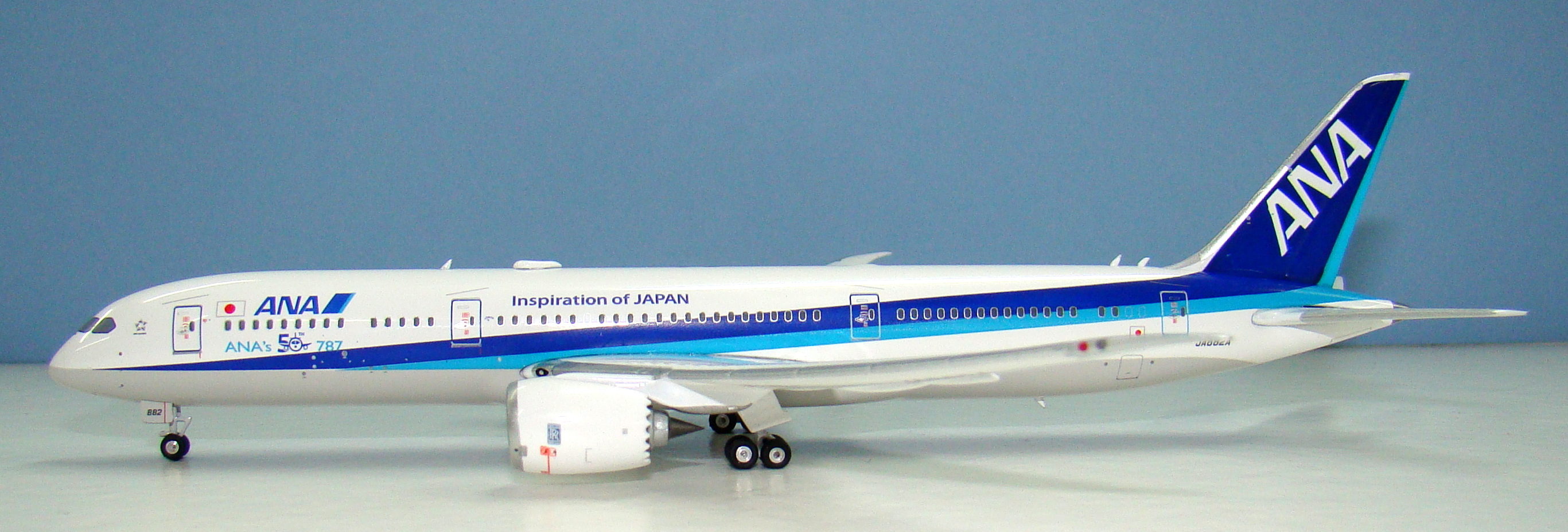
All Nippon is a fairly common airline to be found in 1/400 scale so you’d have thought that Phoenix would have gotten the colours correct after all this time. Sadly they don’t appear to have. The dark blue looks ok but the light blue on the real thing is a bright light blue. On the model the shade is a lot greener and pastel like (the flash in the photos doesn’t show the real colour well).

The application of the livery is good except for at two points. The most obvious is on the tail. The vertical stabilizer has a metal leading edge but there ought to be a clear white line between this and the dark blue stripe. This runs the entire height of the fin but is missing completely from the model’s port side. Oddly it is present on the model’s starboard side so I’m not sure what’s going on there.
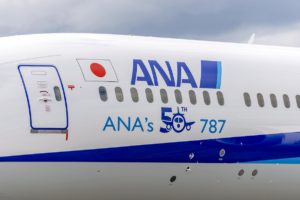
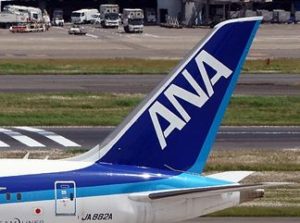
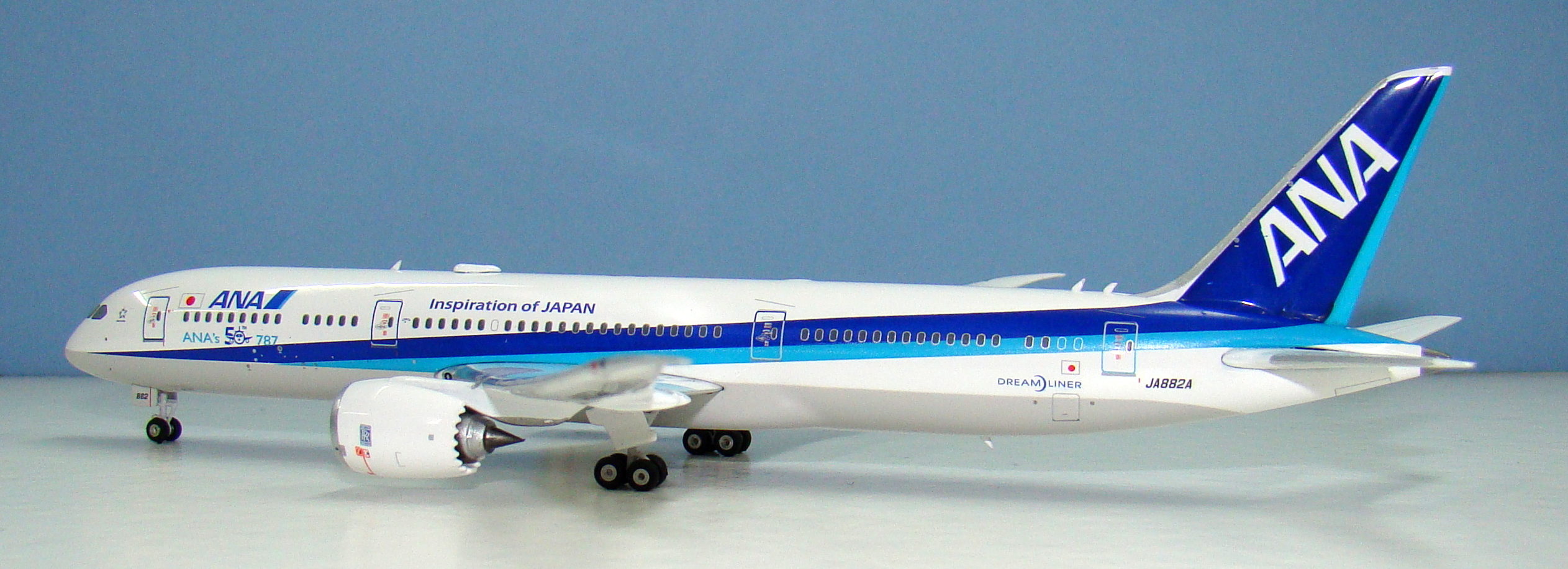
The other inaccuracy is on the port side only, where the ‘ANA’s 50th 787’ titles should not touch the striping at all. On the model most of the 787 part of the text is in contact with the stripe. The special titles themselves are however very accurate and show how to print thin text really well.
SCORE – 7
PRINTING & QUALITY CONTROL
Phoenix have been well known to suffer from some dire printing issues in the past but this model comes with an A+ rating when it comes to the quality of what is printed. Where it falls down is where there isn’t any printing i.e. the underneath. There are not even any maingear door markings let alone anything else.
The other issue is minor but I do think Phoenix print the cockpit windows slightly too large on their 787s. Also for some reason they print them in quite a light grey. In all photos they look a lot darker. One last print issue is the size of the silver engine rims. They aren’t wide enough on the model and don’t slant forwards enough either as on the real thing.

In terms of quality of construction this model is excellently put together. The wings, undercarriage, satnav dome, antennae and horizontal stabilizers are all fitted snugly. If there is a criticism it is that the paint on the wings is rather thickly applied masking some detailing, especially on the underside.
SCORE – 8
CONCLUSION
Is the Phoenix 787 mould still in contention despite the introduction of JC Wings new 787 mould? I’m not sure it is. Certainly the mould could be improved in several key areas. When I compare a Phoenix 787 to the real aircraft the model’s differences (gear height and cockpit window size) actually make it look better than the real aircraft! To me it looks like an idealized version of a 787 rather than the plane Boeing designed. It doesn’t help that on this model the colour is off and the livery imperfectly applied too. Having said all that the model still looks good from distance – just don’t look too closely.
FINAL SCORE – 21/30


